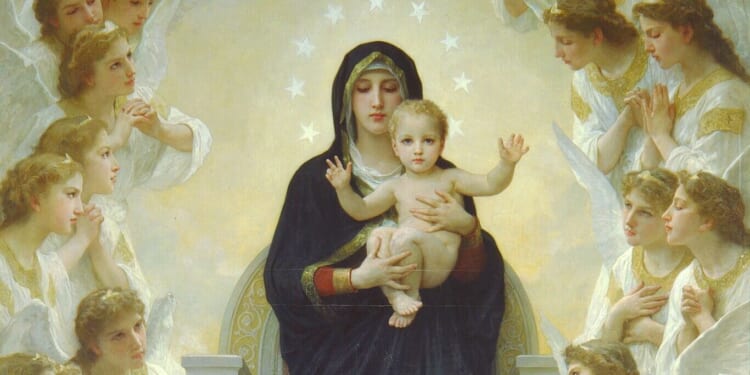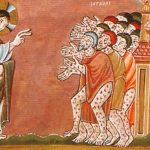Within hours of its publication, my fears that the new “Doctrinal Note on Some Marian Titles Regarding Mary’s Cooperation in the Work of Salvation” by the Dicastery for the Doctrine of the Faith would aggravate divisions in the Church were being fulfilled. Catholic News Agency’s headline “Vatican Nixes Use of ‘Co-Redemptrix’ as Title for Mary” stoked the ire of conservatives even before they had read the article, let alone the DDF’s Doctrinal Note, and John-Henry Westen lamented that “it is a sad day around the world for Catholics devoted to Our Lady.”
But, strictly speaking, was there really any “nixing,” and was the day really as sad as Westen said it was?
First, let me be clear that the Note disappointed me for several reasons. But those are not my present concern.
Rather, I would like to focus on why I think the Doctrinal Note is an opportunity for deeper prayer, discernment, and spiritual enrichment.
To seize that opportunity, you have to read the document—entitled Mater Populi Fidelis (“Mother of the Faithful People”)—itself. The issue of various Marian titles such as “Co-redemptrix” and “Mediatrix” has long been the study not only of theologians, but of the Holy See.
I worked for two popes—Benedict XVI and Francis—at the Vatican Secretariat of State, and the three most common areas of urgent concern brought to the Holy Father’s attention via letters from local bishops were Marian popular piety (especially the titles addressed in Mater Populi Fidelis), the liturgical calendar (especially the attenuation of holy days of obligation by transferring them to Sunday), and the Extraordinary Form (especially the conflict between the liturgical calendars of the Ordinary and Extraordinary Forms).
The timing of the Doctrinal Note should reflect nothing personally upon either Cardinal Victor Manuel Fernández or Pope Leo XIV. When I began my work at the Vatican in 2006, a large dossier of correspondence, reports, and expert opinions was already going back and forth between the Secretariat of State and the Dicastery for the Doctrine of the Faith. The issues addressed in the Doctrinal Note reach at least as far back as Vatican II, when the conciliar fathers discussed at length whether a separate document on Mary and her role in the Church be produced, or whether that material should be incorporated in a special chapter of the Dogmatic Constitution on the Church. They opted for the latter, paving the way for Chapter 8 of Lumen Gentium, which can be considered a summa of the Church’s Mariological teaching in the present age.
The most salient aspect of Mary’s role both in God’s plan for salvation and in our response to His plan is “motherhood.” Mary is described as “Mother of God and Mother of the Redeemer,” as well as “mother of Christ and mother of men” (53). “By reason of the gift and role of divine maternity, by which she is united with her Son, the Redeemer, and with His singular graces and functions, the Blessed Virgin,” the Council teaches, “is also intimately united with the Church” (63).
The Doctrinal Note—just like the Council—invites us to ponder deeply her maternal bond with the Church. The most poignant moment in the formation of this bond occurs just before Jesus gives up His spirit on the cross, entrusting Mary to John as mother and John to Mary as son (Jn. 19:28). Only then does Scripture tell us that everything has been fulfilled.
The Church experiences the grace of this maternal bond with Mary in her daily life. The Note reminds us that this is the reason St. Augustine calls the Virgin a “cooperator” in Christ’s redemption, “emphasizing both Mary’s action at Christ’s side as well as her subordination to him” (9). She is a “cooperator” in the sense that she works with Christ to give birth to the faithful in the Church, and no one could have known this better than St. John who took her into his care before she was assumed body and soul into heaven.
Aside from the controversial use of specific titles to designate Mary’s role in Christ’s redemptive work and in our experience of Christ’s grace today, the Doctrinal Note reminds us that “her prayer for us has a value and an efficacy that cannot be compared to any other intercession” (38). That is why St. John Paul II—following Vatican II—made use of the title “Mediatrix,” noting that Mary “puts herself ‘in the middle,’ that is to say, she acts as a mediatrix: not as an outsider, but in her position as mother. She knows that, as such, she can point out to her Son the needs of mankind” (Redemptoris Mater, 21).
If we had to summarize the spiritual lesson of the Doctrinal Note, it would be that unspeakable treasures lie in cultivating our relationship with the Virgin Mary as our Mother, because she cares for us in a way that utterly transcends even the depth of maternal intimacy we experience on a natural level. Similarly, Mary’s experience of Christ’s saving grace—the fruits of which she enjoyed even in her very conception—unites us with her as fully redeemed by her Son’s passion, death, and resurrection.
The Note thus teaches that we best understand her maternal cooperation as “participatory.” In other words, it involves “a sharing in the one unique source that is the mediation of Christ himself,” though she enters into her Son’s unique mediation in a thoroughly personal way (37).
I owe an enormous debt of gratitude to Pope Benedict XVI, who sharpened and honed the Marian devotion I learned from John Paul II. Though I never worked for the latter, I personally experienced how the former modeled a beautiful Marian piety supported by a fertile theological mind. Benedict is as much to credit for Mater Populi Fidelis as anyone, so it breaks my heart that some are trying to drive a wedge between Benedict XVI and Leo XIV with this document. While still a cardinal, Joseph Ratzinger spoke clearly on problems with the title “Mediatrix of All Graces,” precisely to promote a healthy and sound relationship with Our Lady.
I strongly encourage anyone with the interest and motivation to delve into Mater Populi Fidelis with an open heart and mind. You may still disagree with the DDF’s decision to make a pronouncement on these Marian titles, but you will emerge a more informed and deeply appreciative son or daughter of Mary, Mother of the Church.
Image from Wikimedia Commons












